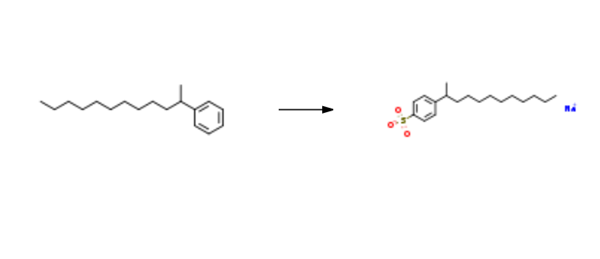Dodecylbenzolsulfons?ure,Natrium-Salz Chemische Eigenschaften,Einsatz,Produktion Methoden
ERSCHEINUNGSBILD
WEISSER BIS GELBER FESTSTOFF IN VERSCHIEDENEN FORMEN.
CHEMISCHE GEFAHREN
Zersetzung beim Erhitzen unter Bildung giftiger und reizender Rauche (Schwefeloxide). Reagiert mit S?uren unter Bildung giftiger und reizender Rauche (Schwefeloxiden).
ARBEITSPLATZGRENZWERTE
TLV nicht festgelegt (ACGIH 2005).
MAK nicht festgelegt (DFG 2005).
AUFNAHMEWEGE
Aufnahme in den K?rper durch Inhalation und durch Verschlucken.
INHALATIONSGEFAHREN
Verdampfung bei 20°C vernachl?ssigbar; eine gesundheitssch?dliche Partikelkonzentration in der Luft kann jedoch beim Dispergieren schnell erreicht werden, vor allem als Pulver.
WIRKUNGEN BEI KURZZEITEXPOSITION
WIRKUNGEN BEI KURZZEITEXPOSITION: Die Substanz reizt die Augen, die Haut und die Atemwege.
WIRKUNGEN NACH WIEDERHOLTER ODER LANGZEITEXPOSITION
Wiederholter oder andauernder Hautkontakt kann Dermatitis hervorrufen.
LECKAGE
Verschüttetes Material in Beh?ltern sammeln; falls erforderlich durch Anfeuchten Staubentwicklung verhindern. Reste sorgf?ltig sammeln. An sicheren Ort bringen. Pers?nliche Schutzausrüstung: Atemschutzger?t, P1-Filter für inerte Partikel.
R-S?tze Betriebsanweisung:
R22:Gesundheitssch?dlich beim Verschlucken.
R37/38:Reizt die Atmungsorgane und die Haut.
R41:Gefahr ernster Augensch?den.
S-S?tze Betriebsanweisung:
S26:Bei Berührung mit den Augen sofort gründlich mit Wasser abspülen und Arzt konsultieren.
S27:Beschmutzte, getr?nkte Kleidung sofort ausziehen.
S36/37/39:Bei der Arbeit geeignete Schutzkleidung,Schutzhandschuhe und Schutzbrille/Gesichtsschutz tragen.
Beschreibung
Sodium dodecyl benzene sulfonate is a series of organic compounds with the formula C12H25C6H4SO3Na. It is a colourless salt with useful properties as a surfactant. It is usually produced as a mixture of related sulfonates. It is a major component of laundry detergent.
Chemische Eigenschaften
white or light yellow flakes
Verwenden
A surfactant used in proteomics research.
Allgemeine Beschreibung
Sodium dodecylbenzenesulfonate is a white to light yellow flakes, granules or powder. Sodium dodecylbenzenesulphonate is soluble in water. The primary hazard is the threat to the environment. Immediate steps should be taken to limit its spread to the environment. Sodium dodecylbenzenesulphonate is used as a synthetic detergent.
Air & Water Reaktionen
Sodium dodecylbenzenesulphonate is soluble in water.
Reaktivit?t anzeigen
SODIUM DODECYLBENZENESULFONATE is incompatible with strong oxidizers.
Health Hazard
Minor skin and eye irritant. INGESTION: May cause vomiting, diarrhea, and intestinal distension.
Industrielle Verwendung
These frothers are mixtures of alcohols containing 6–8 carbon atoms. They were at one
time marketed by DuPont and they are tailored frothers for specific ore types. The bestknown
frother from this group is methyl isobutyl carbinol (MIBC) and 2-ethyl hexanol.
Aliphatic alcohol frothers are used as mixtures of different carbon lengths and as a
mixture of hydrocarbon oils.
Sicherheitsprofil
Poison by intravenous
route. Moderately toxic by ingestion. A skin and
severe eye irritant. When heated to decomposiuon
it emits tomc fumes of NazO. See also
SULFONATES
Synthese
Sodium dodecylbenzenesulphonate is synthesised using 2-phenyldodecane as raw material by chemical reaction. The specific synthesis steps are as follows:
To a 5 L round bottom flask equipped with mechanical stirrer and an addition funnel was added octadecane and 2-phenyldodecane mixture ( 1.73 kg, 28%> 2-phenyldodecane). The reaction mixture was sparged with argon, warmed to 35°C and 1.25 weight % of oleum (632 g, 1.58 mol) was added dropwise, via addition funnel, to reaction mixture. The reaction mixture was stirred for 1.5 hours at room temperature. Upon completion, the reaction mixture was heated to 50°C and transferred to a separatory funnel and allowed to separate. The bottom layer was added slowly to a stirred solution of 15%> NaOH (aq) (2 L) at 10°C. Upon complete addition the resulting suspension was stirred for an additional 60 minutes. The solid was subsequently isolated by filtration and washed twice with ice-cold water. The solids were air dried for 16 hours and vacuum dried at 80°C to yield sodium, 4-(dodecan-2-yl) benzenesulfonate (555 g, 80.8% yield, 98.5% purity). lH NMR (400 MHz, (CD3)2S0/CDC13) δ 0.84 (t, J = 7.0 Hz, 3H), 0.95- 1.38 (m, 19H), 1.51 (pquart, J = 7.3 Hz, 2H), 2.65 (psext, J = 7.0 Hz, 1 H), 7.1 1 (d, J = 7.6 Hz, 2H), 7.56 (d, J = 8.4 Hz, 2H). 13C NMR (101 MHz, (CD3)2S0/CDC13) δ 13.8, 22.0, 22.1 , 27.0, 28.9, 28.9, 28.9, 28.9, 31.2, 37.6, 38.8, 125.4, 125.8, 145.3, 147.7.

l?uterung methode
It crystallises from propan-2-ol or H2O. [Gray et al. J Org Chem 20 515 1955, Beilstein 11 IV 514.]
Dodecylbenzolsulfons?ure,Natrium-Salz Upstream-Materialien And Downstream Produkte
Upstream-Materialien
Downstream Produkte

